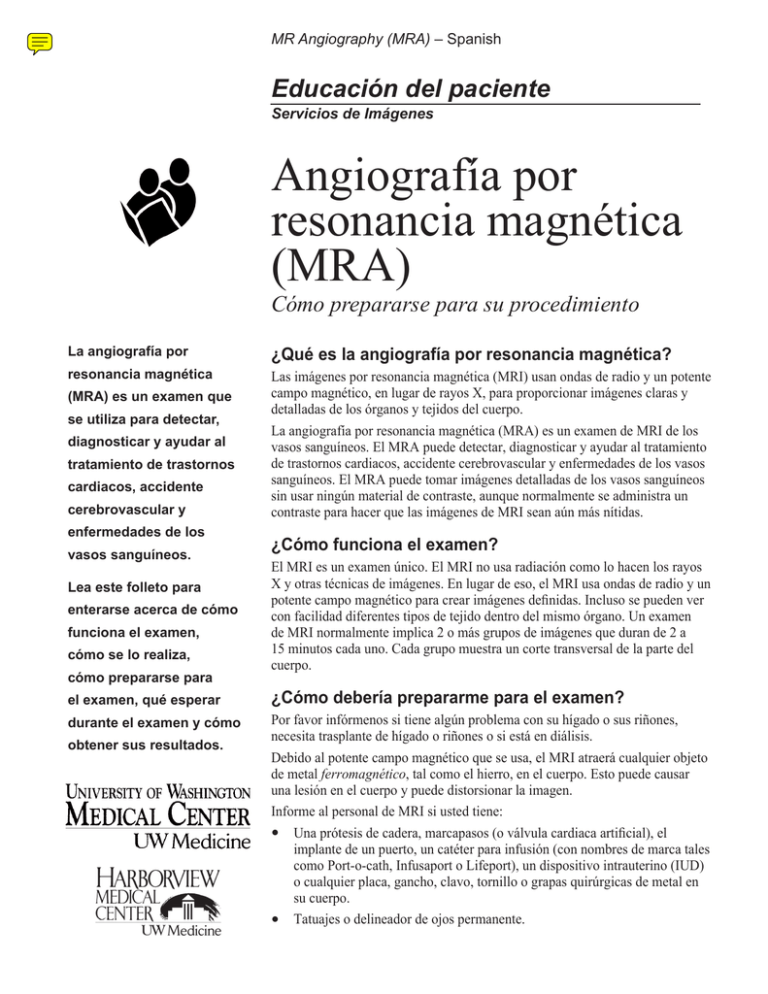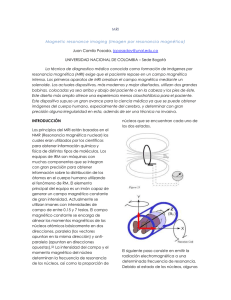Angiografía por resonancia magnética (MRA)
Anuncio

MR Angiography (MRA) – Spanish Educación del paciente Servicios de Imágenes Angiografía por resonancia magnética (MRA) Cómo prepararse para su procedimiento La angiografía por resonancia magnética (MRA) es un examen que se utiliza para detectar, diagnosticar y ayudar al tratamiento de trastornos cardiacos, accidente cerebrovascular y enfermedades de los vasos sanguíneos. Lea este folleto para enterarse acerca de cómo funciona el examen, cómo se lo realiza, cómo prepararse para ¿Qué es la angiografía por resonancia magnética? Las imágenes por resonancia magnética (MRI) usan ondas de radio y un potente campo magnético, en lugar de rayos X, para proporcionar imágenes claras y detalladas de los órganos y tejidos del cuerpo. La angiografía por resonancia magnética (MRA) es un examen de MRI de los vasos sanguíneos. El MRA puede detectar, diagnosticar y ayudar al tratamiento de trastornos cardiacos, accidente cerebrovascular y enfermedades de los vasos sanguíneos. El MRA puede tomar imágenes detalladas de los vasos sanguíneos sin usar ningún material de contraste, aunque normalmente se administra un contraste para hacer que las imágenes de MRI sean aún más nítidas. ¿Cómo funciona el examen? El MRI es un examen único. El MRI no usa radiación como lo hacen los rayos X y otras técnicas de imágenes. En lugar de eso, el MRI usa ondas de radio y un potente campo magnético para crear imágenes definidas. Incluso se pueden ver con facilidad diferentes tipos de tejido dentro del mismo órgano. Un examen de MRI normalmente implica 2 o más grupos de imágenes que duran de 2 a 15 minutos cada uno. Cada grupo muestra un corte transversal de la parte del cuerpo. el examen, qué esperar ¿Cómo debería prepararme para el examen? durante el examen y cómo Por favor infórmenos si tiene algún problema con su hígado o sus riñones, necesita trasplante de hígado o riñones o si está en diálisis. Debido al potente campo magnético que se usa, el MRI atraerá cualquier objeto de metal ferromagnético, tal como el hierro, en el cuerpo. Esto puede causar una lesión en el cuerpo y puede distorsionar la imagen. Informe al personal de MRI si usted tiene: • Una prótesis de cadera, marcapasos (o válvula cardiaca artificial), el implante de un puerto, un catéter para infusión (con nombres de marca tales como Port-o-cath, Infusaport o Lifeport), un dispositivo intrauterino (IUD) o cualquier placa, gancho, clavo, tornillo o grapas quirúrgicas de metal en su cuerpo. • Tatuajes o delineador de ojos permanente. obtener sus resultados. Página 2 Servicios de Imágenes Angiografía por resonancia magnética (MRA) • • • • Parches con medicamentos. • • Alergias a medicamentos. Una bala o esquirla en su cuerpo. Si alguna vez ha trabajado con metal. Tapaduras o frenillos dentales. Estos artículos normalmente no son afectados por el MRI, pero podrían distorsionar las imágenes de la cara o del cerebro. Tuvo alguna cirugía. Asegúrese también de informar al personal si está o pudiera estar embarazada. En la mayoría de los casos, las grapas quirúrgicas, ganchos, clavos y tornillos no representan un riesgo durante el MRI si han estado colocados durante más de 4 a 6 semanas. Si existe una duda sobre fragmentos de metal, se puede tomar rayos X para detectarlos. ¿Cómo se realiza el examen? 1. Usted se recostará en una mesa deslizante y se pondrá alrededor de la parte de su cuerpo un dispositivo denominado bobina de superficie. 2. Después de moverlo(a) dentro de la unidad de MRI, el técnico saldrá de la sala y tomará las imágenes de MRI. 3. Usted podrá hablar en cualquier momento con el técnico de MRI a través de un intercomunicador. 4. En base a cuántas imágenes sean necesarias, el examen tomará de 30 a 60 minutos, aunque un estudio muy detallado podría tomar más tiempo. 5. Se le pedirá que no se mueva mientras se están tomando las imágenes. 6. Algunos pacientes necesitarán una inyección de un material de contraste para que algunos tejidos o vasos sanguíneos sean más fáciles de ver. El material de contraste se inyecta aproximadamente a la mitad del examen. Si necesita contraste, se le inyectará a través de una aguja pequeña en una vía intravenosa (IV) en una vena del brazo o de la mano. 7. Después del examen, se le pedirá que espere hasta que se revisen las imágenes en cuanto a la calidad. Se tomarán más imágenes si fuera necesario. ¿Qué sentiré durante el examen de MRI? • • El MRI no produce dolor. Algunos pacientes que se someten a un MRI en una unidad cerrada se podrían sentir confinados o inquietos (claustrofóbicos). Por favor infórmele al médico que le refirió para el MRI si usted es claustrofóbico(a). Podría recibir un medicamento para ayudarle a relajarse. Servicios de Imágenes Angiografía por resonancia magnética (MRA) ¿Preguntas? Sus preguntas son importantes. Si tiene preguntas o inquietudes, llame a su médico o proveedor de atención a la salud. El personal de la clínica está también disponible para ayudar. q Servicios de Imágenes de UWMC: 206-598-6200 q Servicios de Imágenes de Harborview: 206-744-3105 UWMC Imaging Services Box 357115 1959 N.E. Pacific St. Seattle, WA 98195 206-598-6200 • Podría notar una sensación de calor en el área objetivo. Esto es normal; sin embargo, si le causa molestia, infórmele al técnico de MRI. • Si se necesita una inyección de contraste, podría sentir incomodidad en el sitio de la inyección. También podría tener una sensación de frío en el sitio durante la inyección. • Para muchos pacientes, los ruidos fuertes de golpecitos o golpeteos en ciertos momentos del examen son molestos. Se proporcionará tapones para los oídos o música. ¿Quién interpreta los resultados y cómo los obtengo? Un radiólogo especializado en MRI revisará e interpretará sus imágenes de MRI. El radiólogo no conversará sobre los resultados con usted, sin embargo, enviará un informe a su médico de atención primaria o referente. Este médico le dará los resultados. © University of Washington Medical Center MR Angiography (MRA) Spanish 03/2005 Rev. 05/2009 Reprints: Health Online Patient Education Imaging Services MR Angiography (MRA) How to prepare for your procedure Magnetic resonance What is MR angiography? angiography (MRA) is an Magnetic resonance imaging (MRI) uses radio waves and a strong magnetic field instead of X-rays to provide clear and detailed pictures of the body’s organs and tissues. exam used to detect, diagnose, and aid the treatment of heart disorders, stroke, and blood vessel diseases. Read this handout to learn about how the exam works, how it is done, how to prepare for it, what to expect during the exam, and how to get your results. MR angiography (MRA) is an MRI exam of the blood vessels. MRA can detect, diagnose, and aid the treatment of heart disorders, stroke, and blood vessel diseases. MRA can take detailed pictures of blood vessels without using any contrast material, although a contrast usually is given to make the MRI pictures even more clear. How does the exam work? MRI is a unique exam. MRI does not use radiation like X-rays and other imaging techniques do. Instead, MRI uses radio waves and a strong magnetic field to create sharp pictures. Even different types of tissue within the same organ can easily be seen. An MRI exam usually involves 2 or more sets of pictures that last 2 to 15 minutes each. Each set shows a cross-section of the body part. How should I prepare for the exam? Please tell us if you have any problems with your liver or kidneys, need a liver or kidney transplant, or if you are on dialysis. Because of the strong magnetic field used, MRI will pull on any ferromagnetic metal object, such as iron, in the body. This can cause injury in the body and can distort the image. Tell the MRI staff if you have: • A prosthetic hip, heart pacemaker (or artificial heart valve), implanted port, infusion catheter (with brand names such as Porto-cath, Infusaport, or Lifeport), intrauterine device (IUD), or any metal plates, clips, pins, screws, or surgical staples in your body. • Tattoos or permanent eyeliner. Page 2 Imaging Services MR Angiography (MRA) • Medicine patches. • A bullet or shrapnel in your body. • Ever worked with metal. • Tooth fillings or braces. These items are usually not affected by the MRI, but they may distort pictures of the face or brain. • Drug allergies. • Had any surgeries. Also be sure to tell staff if you are or may be pregnant. In most cases, surgical staples, clips, plates, pins, and screws are not a risk during MRI if they have been in place for more than 4 to 6 weeks. If there is any question of metal fragments, an X-ray may be done to check for them. How is the exam done? 1. You will lie on a sliding table and a device called a surface coil will be placed around the body part. 2. After moving you inside the MRI unit, the technologist will leave the room and take the MRI pictures. 3. You will be able to talk with the MRI technologist at any time through an intercom. 4. Based on how many pictures are needed, the exam will take 30 to 60 minutes, although a very detailed study may take longer. 5. You will be asked not to move while pictures are being taken. 6. Some patients will need an injection of a contrast material to make some tissues or blood vessels easier to see. The contrast material is injected about halfway through the exam. If you need the contrast, it will be injected through a small needle and an intravenous (IV) line in an arm or hand vein. 7. After the exam, you will be asked to wait until the pictures are checked for quality. More pictures will be taken if needed. What will I feel during the MRI exam? • MRI does not cause pain. • Some patients who have an MRI in an enclosed unit may feel confined or uneasy (claustrophobic). Please tell the doctor who referred you for the MRI if you are claustrophobic. You may receive medicine to help you relax. Imaging Services MR Angiography (MRA) Questions? Your questions are important. Call your doctor or health care provider if you have questions or concerns. Clinic staff are also available to help. UWMC Imaging Services: 206-598-6200 • You may notice a warm feeling in the target area. This is normal, but if it bothers you, tell the MRI technologist. • If a contrast injection is needed, you may feel discomfort at the injection site. You may also have a cool sensation at the site during the injection. • For many patients, the loud tapping or knocking noises at certain times of the exam are annoying. Earplugs or music will be provided. Who interprets the results and how do I get them? A radiologist skilled in MRI will review and interpret your MRI images. The radiologist will not discuss the results with you, but will send a report to your primary care or referring doctor. This doctor will give you the results. Harborview Imaging Services: 206-744-3105 __________________ __________________ __________________ __________________ UWMC Imaging Services Box 357115 1959 N.E. Pacific St. Seattle, WA 98195 206-598-6200 © University of Washington Medical Center 03/2005 Rev. 05/2009 Reprints: Health Online

